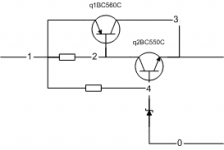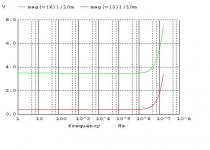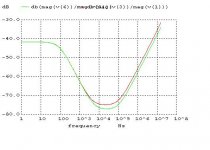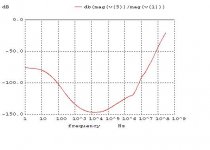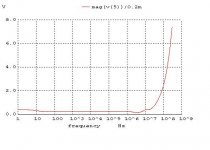It has been hinted at least by Elso Kwak that you could use a Sziklai pair emitter follower as stabilizer.
Is this a common practice? Quick simulations indicate that there is a bit lower output impedance at the cost of a few dB worse PSRR at the high end.
Circuit:
Is this a common practice? Quick simulations indicate that there is a bit lower output impedance at the cost of a few dB worse PSRR at the high end.
Circuit:
Attachments
Hjelm,
Increasing R1-4 would help the PSRR as this is influenced by the ratio R1-4 and the zener dynamic impedance. Increasing R1-2 to say 1k would lower the Zout.
But final values can only bedetermined if you know the max load current, because that determines the Q-type for the pass element and the requirements for base current. But at any rate it should be a large improvement from a simple emitter follower.
Look at it this way: it's like a black box with 3 terminals. Now inside the bb you have an element that comes much closer to an ideal xsistor. Naturally, everything improves, generally speaking.
Jan Didden
Increasing R1-4 would help the PSRR as this is influenced by the ratio R1-4 and the zener dynamic impedance. Increasing R1-2 to say 1k would lower the Zout.
But final values can only bedetermined if you know the max load current, because that determines the Q-type for the pass element and the requirements for base current. But at any rate it should be a large improvement from a simple emitter follower.
Look at it this way: it's like a black box with 3 terminals. Now inside the bb you have an element that comes much closer to an ideal xsistor. Naturally, everything improves, generally speaking.
Jan Didden
Jan,
Thanks for the quick replies.
Tried increasing the R1-4 and got a broader dip in the PSRR but the maximum level was unchanged.
If i increased the R1-2 though the PSRR got worse at the high end and the output impedance decreased.
My quick conclusion is that there is,as always, a tradeoff.
Question is it seems worth doing since it is a simple change from the emitter follower why isn't it used more, is there a sonic problem with it? I see one nice feature in the output impedance which seems to be in the 300mohm range and constant in the audio band for these small signal transistors.
Thanks for the quick replies.
Tried increasing the R1-4 and got a broader dip in the PSRR but the maximum level was unchanged.
If i increased the R1-2 though the PSRR got worse at the high end and the output impedance decreased.
My quick conclusion is that there is,as always, a tradeoff.
Question is it seems worth doing since it is a simple change from the emitter follower why isn't it used more, is there a sonic problem with it? I see one nice feature in the output impedance which seems to be in the 300mohm range and constant in the audio band for these small signal transistors.
Yes, there always is a trade-off, as with everything in life.
How do you test the PSRR? Where/what is the input, what the measuring point?
It IS done often, like in using an integrated regulator like the 317 series with an external pass xsistor. Same concept.
Don't ask me about the sonic implecations, I have tin ears.
Jan Didden
How do you test the PSRR? Where/what is the input, what the measuring point?
It IS done often, like in using an integrated regulator like the 317 series with an external pass xsistor. Same concept.
Don't ask me about the sonic implecations, I have tin ears.
Jan Didden
Improved this a bit as i thought the PSRR was the major problem with this circuit as a stabilizer.
I found the shunt that was described on this page, finesse voltage regulator, very useful to remove incoming voltage variations.
I modified it to use a Sziklai pair, i like the configuration.
I then needed to modify the resistor at the emitter to achieve optmal rejection.
The final circuit i simulated looks like this.
I found the shunt that was described on this page, finesse voltage regulator, very useful to remove incoming voltage variations.
I modified it to use a Sziklai pair, i like the configuration.
I then needed to modify the resistor at the emitter to achieve optmal rejection.
The final circuit i simulated looks like this.
Attachments
hjelm said:Jan,
I do not know if it is correct but i did a AC sweep at 1 (input) and read it out at three (output) and and did a 20*log10(Voltage_ratio)
I am not that experienced with spice but intuitively i thought it should say something.
/Hjelm
Yes, that's correct, although it is a small-signal simulation, which may be a bit optimistic. But it's a good indication.
Jan Didden
The capacitors are modelled with ESR and estimated inductance.
With these i extended the frequency before the output impedance started to rise.
I got quite nice figures for the PSRR (i think at least).
When is it good enough?
The application is firstly to decouple a opamp but i think it would work for a DAC as well.
Does anyone have any opinions on criteria for a good supply for a DAC and opamp respectively, or is there no free lunch.
With these i extended the frequency before the output impedance started to rise.
I got quite nice figures for the PSRR (i think at least).
When is it good enough?
The application is firstly to decouple a opamp but i think it would work for a DAC as well.
Does anyone have any opinions on criteria for a good supply for a DAC and opamp respectively, or is there no free lunch.
Attachments
The output impedance is resistive from 10Hz to 500kHz and i get a THD of 0.42% if i load the circuit with 20mA and a 1mA sinus on top, read that linearity might be an important factor in a PSU.
I have also experimented with the shunt to remove the zener noise and it can give a 100dB improvement.
Comments?
I have also experimented with the shunt to remove the zener noise and it can give a 100dB improvement.
Comments?
hjelm said:The output impedance is resistive from 10Hz to 500kHz and i get a THD of 0.42% if i load the circuit with 20mA and a 1mA sinus on top, read that linearity might be an important factor in a PSU.
I have also experimented with the shunt to remove the zener noise and it can give a 100dB improvement.
Comments?
The 100dB improvement is most certainly due to simulation or measurement artifacts. That kind of attenuation will not be realised in practise.
I think you are again getting close to the point to decide whether you want substantial improvements, like sub-1-milli-ohm Zout and go to a real regulator (with feedback) or stay with the emitter follower that you have now. I don't think that there is much more to gain except some tweaking as you noted.
Jan Didden
- Status
- This old topic is closed. If you want to reopen this topic, contact a moderator using the "Report Post" button.
- Home
- Amplifiers
- Solid State
- Sziklai emitter follower as voltage stabilizer
